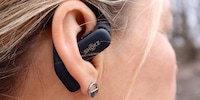

Shokz Open Swim Pro review: soundtrack for swim training
The Shokz bone conduction headphones family has a new addition: the Open Swim Pro. They’re strong multi-sport headphones and feel particularly comfortable in the water. But there are two things that could definitely be better.
Anyone who does triathlons, swimming or water sports will be familiar with long training sessions that would be so much better with music. But as electronics and water don’t mix well, even splash-proof headphones aren’t an option.
That’s why bone conduction headphone specialist Shokz (formerly Aftershokz) launched the Open Swim headphones years ago, which are actually an MP3 player for water. This model now has a successor: the Open Swim Pro.
Ideal for multi-sport athletes: two sets of headphones in one
What’s special about the new model? The Open Swim Pro is a really good MP3 player in the form of headphones for water. And on land, like the Open Run Pro, it’s a wireless Bluetooth (V5.4) model that plays music, podcasts and audiobooks to your auditory nerve via your cheekbones while you exercise. Of course, you can also use the Open Swim Pro as an MP3 player on land, for example if you don’t want to take your smartphone with you when you go jogging.
Instead of two sets of headphones – one for swimming and the other for running, cycling, yoga or whatever else you do – you now only need one. Even if you do the occasional stand-up paddle board, kayak or wing foil session, the Open Swim Pro is a good option. With one caveat – more on that later.
I’d already tested the Open Run Pro (you can find the test report here), and now I’ve also been wearing the amphibious Open Swim Pro for several weeks during sporting activities.
They score highly on technical details
Visually, the new member of the Shokz family doesn’t differ much from its predecessor, the Open Swim headphones or the Open Run Pro, apart from the colour (the Open Swim Pro is available in orange-blue and a subtle grey). They’re also flexible and made of a nickel-titanium alloy coated with silicone. The internal storage has been increased from four to 32 gigabytes. That’s enough for around 8,000 of your most motivating songs.
Like the other two Shokz headphones models, the Open Swim Pro sits in front of the ear canal rather than on it, so you don’t totally block out your surroundings. If you’ve used Shokz bone conduction headphones before, you know what to expect.
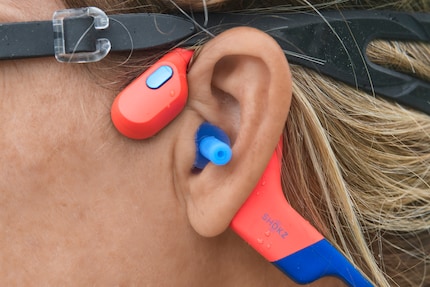
Source: Stefan Munsch
Keeping your ear canal clear provides greater safety when jogging and cycling. And when swimming, the Open Swim Pro even works with earplugs. For me, this is a big plus because I like swimming in open water and I easily develop problems without earplugs, especially in colder temperatures.
The earpieces nestle around the outer ear and the piece that extends down to the neck doesn’t bother me. My ears are usually quite sensitive and I have to take off even headphones that others find comfortable after an hour at most. I wore the Open Swim Pro for several hours during exercise and in everyday life. They neither pinch nor wobble. I can also wear them with sunglasses or swimming goggles. And at 27.3 grammes, they’re so light that I hardly notice them at all.
Easy to use – thanks to the buttons!
Other headphones, including the Shokz Open Fit that I wrote about here, use mini touch pads for controls. This doesn’t work for me at all when I’m exercising. That’s why I’m grateful for the small but easy-to-touch buttons on the Open Swim Pro.
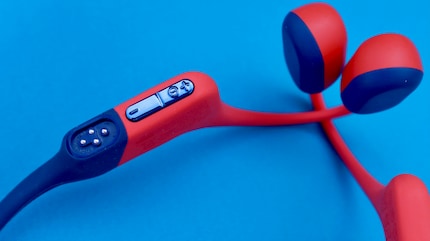
Source: Siri Schubert
You can use the small buttons on the right-hand side to turn the headphones on and off, adjust the volume and switch between swimming and standard mode. The button on the outside of the left earbud lets you stop the sound, skip forward or back and answer calls.
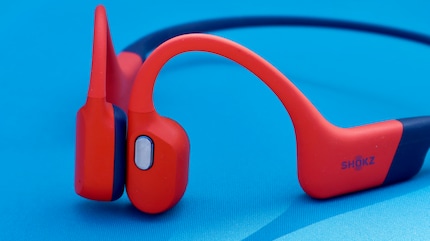
Source: Siri Schubert
The controls work well even with wet hands when swimming, with the exception of answering calls, of course, because you don’t have a Bluetooth connection in the water.
Fine-tuning and multipoint pairing in the app
You can do some fine-tuning using the Shokz app, which is available for iOS and Android. I also set the headphones to standard mode when swimming because I find the sound to be fuller, but that comes down to personal choice.
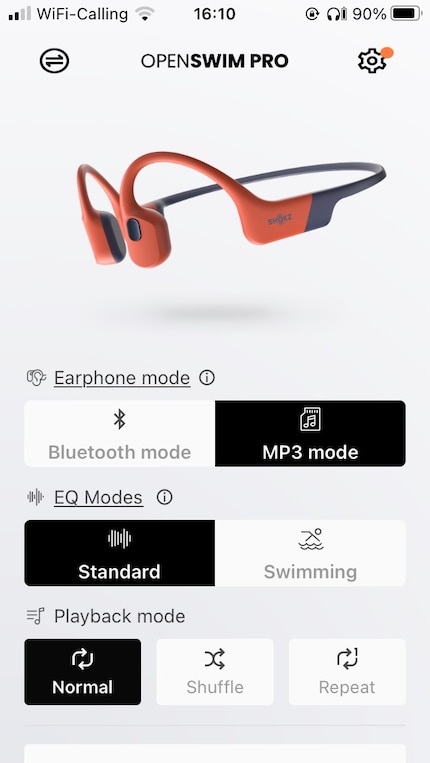
Source: Shokz
You can also use the headphones without the app, but you’d miss out on one specific function: multipoint pairing. This allows you to connect the headphones to two devices at the same time. For example, if you’re watching videos on your tablet or laptop and want to take a call on your smartphone. Or if you want to go for a run with your smartphone without having to unplug and re-pair the headphones first.
MP3 and Bluetooth – the best of both worlds and a nuisance
With the Bluetooth connection, the Open Swim Pro works like the Open Run Pro – very well. The connection is stable and the controls work perfectly.
To play music for the headphones’ MP3 function from your computer, you need the data and charging cable provided. And that’s where I was taken aback when I unpacked it: USB-A? Really? In 2024, that’s really outdated. Luckily, I have a USB-A to USB-C adapter for my Mac Mini, otherwise I’d have been stuck.
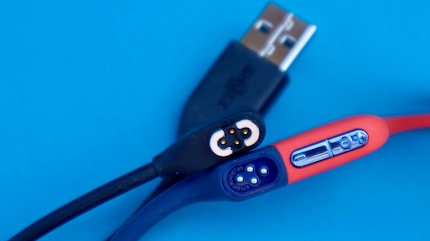
Source: Siri Schubert
It’s easy to transfer music files and audiobooks (in MP3, WMA, FLAC, WAV, AAC, M4A and APE formats) to the headphones’ internal 32-gigabyte hard drive. That’s significantly more than the previous model’s 4 gigabytes. So far, so good.
And now comes one of the two frustrations (the second came up in the water) that dampen my enthusiasm: you can’t organise the music and audiobooks into playlists. This means that the player either plays the maximum of 8,000 songs in order, in a loop or on shuffle mode.
Listening to different music for swimming than running? No chance. And to find the audiobook that I downloaded onto my headphones, I clicked through what felt like 120 songs. To no avail. If there’s a way to get around this problem, I haven’t found it.
In the water
It’s time to get in the water. I’m surprised at how good the headphones sound when I’m swimming. Unlike the tinny, flat sound of older bone conduction headphones from other brands, I can hear bass, treble, vocals and instrumentals well.
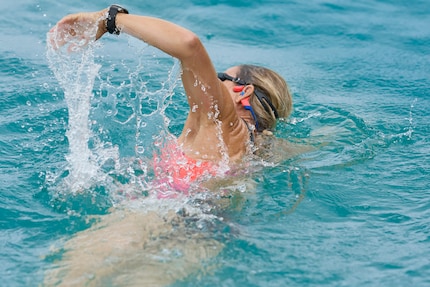
Source: Stefan Munsch
And here’s the obligatory warning for audiophiles: keep your hands off. The Shokz Open Swim Pro are open-ear sports headphones that aren’t made for maximum music enjoyment; they’re for listening to your favourite soundtrack while exercising. And they do that really well.
When I swim in a quiet lake, I can hear the music much better than when I swim lengths in a crowded pool, which is naturally louder. Worn with the goggles, they hold well. I don’t wear a swimming cap because I don’t like the constricting feeling, so I can’t judge how the headphones work with one.
Despite all the excitement, here’s the second frustration and the big BUT: the headphones don’t float. They sink. It doesn’t make sense to me. The lack of buoyancy (which should be easy to guarantee at 27 grammes) makes wearing the headphones risky in the lake, where they’d sink to the bottom if you weren’t careful. This also means that they’re only suitable for sports such as stand-up paddling, wing foiling, surfing, etc. to a limited extent without a safeguard. In any case, I’ll be attaching them to my swimsuit, shirt or goggles with a strap in future.
The fact that the headphones have an IP68 rating and can survive up to two hours in water up to two metres deep is scant consolation. Because if they sink in open water, they’ll certainly sink deeper.
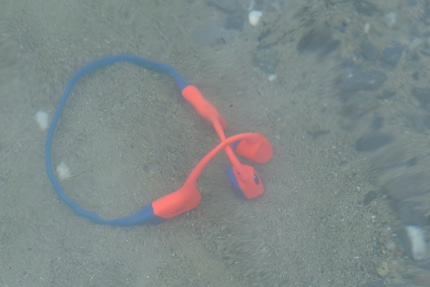
Source: Stefan Munsch
Good sound even on land
When jogging and cycling, I can’t tell the difference in sound compared to the Open Run Pro, even though the Open Swim Pro uses the eighth generation of bone conduction technology and the Open Run Pro uses the ninth. For me, that means they’re top-drawer bone conduction headphones. One tip: if you use the headphones in MP3 mode on land, you should make sure that you have them in standard mode, not in swimming mode – otherwise your chosen track will sound flat.
The battery life of six hours in MP3 mode and nine hours in Bluetooth mode has been enough for my activities so far. However, that’s not what I get if I use the full volume more often. The quick charge function is an additional plus, getting the headphones ready for three hours of use in ten minutes.
The headphones are also useful in everyday life. The noise-cancelling microphones let you make phone calls and I’ve even used them for video calls. Of course, they don’t perform as well here as headphones made for office and everyday use. But if you only want a pair of headphones mainly for sports and only occasionally in everyday life, the Open Swim Pro could be the right choice for you.
In a nutshell
The all-rounder for outdoor adventures
If you’re looking for sports headphones to train for a triathlon, a swimming event or other outdoor sports, the Open Swim Pro are a good choice. Provided you like bone conduction headphones that allow you to be aware of your surroundings while exercising, and you’re prepared to make small compromises in terms of sound.
The dual function with Bluetooth connection and MP3 makes the headphones very versatile. Not just for swimming, but also if you want to go jogging without a smartphone. They replaced my Open Run Pro during my test, as I appreciate being able to use just one pair of headphones for all sports. Overall, the headphones convinced me as an all-rounder for all outdoor sports which can get wet.
There are deductions for the lack of buoyancy and the inability to sort the songs or audiobooks in the MP3 player into playlists or folders.
Pro
- waterproof up to a depth of two metres
- suitable for many sports in water and on land
- able to hear your surroundings via bone conduction technology
- good sound with strong bass
- MP3 and Bluetooth in one device
- noise-cancelling microphone for phone calls
- fast charging function
- suitable for everyday use
Contra
- no way to organise music, podcasts and audiobooks
- not enough buoyancy, they sink in water

Research diver, outdoor guide and SUP instructor – I love being in, on and around water. Lakes, rivers and the ocean are my playgrounds. For a change of perspective, I look at the world from above while trail running or flying drones.

